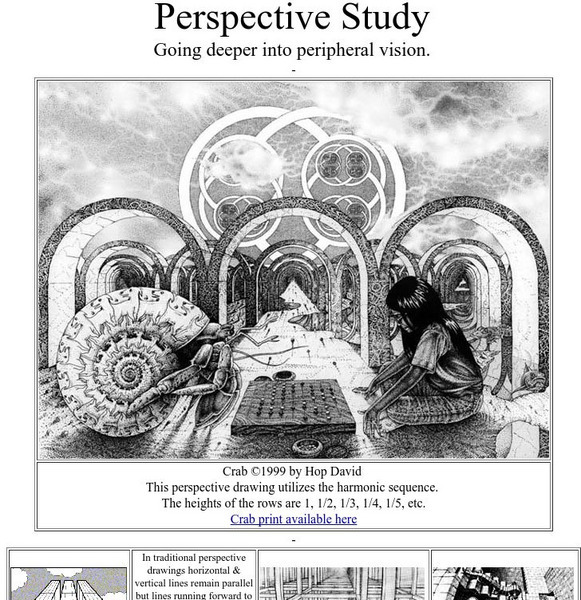Curated OER
Escher-Esque Tessellations
Middle and high schoolers participate in a seven-part activity creating Escher-Esque tessellations. They demonstrate their knowledge of geometric transformations after viewing a PowerPoint presentation, conducting Internet research, and...
Dick Blick Art Materials
Have a Ball!
M.C. Escher's "Hand with Reflecting Globe" and the work of Dick Termes, inspire this activity. Kids check out their reflection in a Christmas ornament or a bubble filter and recreate this distorted image on a vinyl ball.
K12 Reader
The Art of M.C. Escher
Show your class one way in which art and math are related by teaching them about M.C. Escher. Class members read a brief passage and then respond to five related questions.
National Gallery of Canada
Tantalizing Tessellations!
Examine repeating and intricate patterns with a study of M.C. Escher and a related art activity. Pupils view and discuss the artwork before creating their own tessellating patterns. Step-by-step instructions for creating a template are...
National Gallery of Canada
My Upside-Down World!
M.C. Escher is famous for creating optical illusions. Examine this effect in several of his works and discuss the techniques involved. Inspired by the discussion, learners create an imaginary 3-D world inside of a box using various...
National Gallery of Canada
Lumps, Bumps, Gritty, and Soft!
Texture can really add to a work of art. Explore texture through observation and practice. Learners view and discuss works of art by M.C. Escher. They then create their own texture samplers with six different materials.
National Gallery of Canada
Self-Portrait, Mirrors and Metamorphosis!
Using M.C. Escher's Hand with Reflecting Sphere as inspiration, learners create their own set of self-portraits using various reflective surfaces. The instructional activity begins with a discussion about portraiture and ends with a...
Incredible Art
1, 2, and 3-Point Perspective
Introduce drawing students to perspective with a series of lesson that detail how to draft images in one-, two-, and three-point perspective. Each exercise includes step-by-step, illustrated directions and examples.
Curated OER
The Wonderful World of Escher
Bridging art and math can be as easy as making tessellations. The art, context, and life of M.C. Escher is explained to the class, as is the concept of tessellations. After a bit of art history, pupils get out the ruler, tape, and...
Curated OER
Op Art Shapes
Op art is fun to look at, and it's fun to make. Kids learn about the origins of op art and the op art master, M.C. Escher. They view simple to complex examples of op art to see how it works and then create an optical piece of their own....
Curated OER
Enticing Tessellations
Students respond to visual effects used in M.C. Escher's artworks. They identify the difference between subject matter and background of visual art. They compare and contrast the basic shapes to create a tessellation with the more...
Curated OER
Transformations, Tessellations, and Technology
Learners complete a unit about transformations and tessellations. They explore various tessellation websites, determine which shapes tessellate, complete a log about which website activities they complete, and create a tessellation...
Curated OER
Tantalizing Tessellations Lesson III: Creating a Slide Translation
Young scholars explore tessellations and the artwork of M.C. Escher. They view and discuss a video about M.C. Escher, create a slide template out of cardboard, and create a poster with their tessellation pattern.
Curated OER
Geometric Transformations
Learners examine images and preimages of a mapping and identify isometry. They view images by M.C. Escher, observe teacher demonstrations, and create a translation image, a rotation image, and a dilation.
Curated OER
Intuitive Approach to Limits
Students view examples of art work that illustrate limits in calculus. Students will lecture on limits and then complete practice drill. This lesson does not include a defined procedure or practice problems. All the art links work but...
Curated OER
Tessellations
In this tessellation worksheet, learners explore tessellations and create a pattern without overlaps or spaces. After creating the tessellation, they color the shapes. This one-page worksheet contains dot paper for ease in creating a...
Curated OER
Symmetry: Theory, Reality and Art!
Learners explore the concept of geometric symmetry. In this geometric symmetry lesson, students walk around their school and take pictures of objects that demonstrate symmetry. Learners use Microsoft Paint to draw the lines of symmetry...
Curated OER
Tessellations and T-Shirts
Students combine the visual arts and technology with mathematics in the creation of these beautiful t-shirts. They view examples of the work of artist M.C. Escher.
Curated OER
Visual Arts: Matisse and Escher
Third graders are introduced to the art of Henri Matisse and M.C. Escher. They create original works in the styles of Matisse and Escher and consider how their innovations have affected modern art.
Oswego City School District
Regents Exam Prep Center: Review of Transformations
Review of material on transformations, which offers definitions and examples, as well as worksheets and resources for extending instruction. Follow links to find guidelines for examining transformations using a Geometer's Sketchpad.
Other
World of Escher: House of Stairs
This site provides an image of M.C. Escher's famous lithograph, "House of Stairs," which can be enlarged by clicking on it. Included is a quote, which briefly explains how this piece of art introduces "[a] playful element" to "the...
University of St. Andrews (UK)
University of St. Andrews: George Polya
This University of St. Andrews site offers a biography of George Polya. Many links are provided.
Other
Hop's Gallery: Perspective Study
This webpage explores traditional perspective drawings as well as contemporary drawings, focusing on their use of horizontal and vertical lines.
Other
Etropolis: Escher's House of Stairs
Site provides an excellent picture of Escher's "House of Stairs," along with a small description of the lithograph below the picture.























